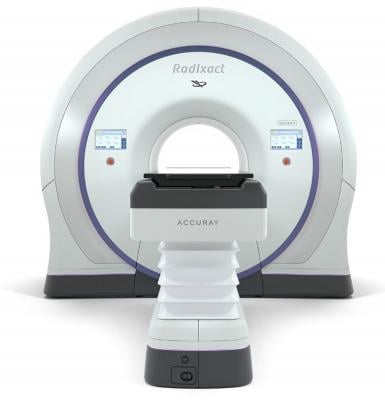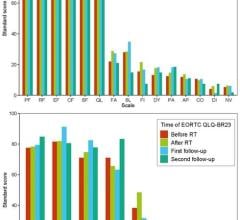
August 10, 2017 — Accuray Inc. announced that the first studies validating the benefits of the Radixact System were presented at the 59th Annual Meeting of the American Association of Physicists in Medicine (AAPM), held July 30-Aug. 3 in Denver. This smart radiation therapy system represents the next generation in TomoTherapy treatment delivery, significantly increasing treatment speed and ease of use, according to Accuray. The Radixact System enables clinicians to treat a wide range of cancer cases, from initial plan delivery to adaptive therapy to complex retreatments, with precision and increased efficiency.
Research highlights include:
Faster planning and reduced treatment time
A study evaluated the performance of the Radixact System based on a comparison of treatment plans developed for this system and the TomoHDA System. Treatment plans were created using the VoLO Planning Solution for the TomoHDA technology, then recreated using the Accuray Precision Treatment Planning System (TPS) for the Radixact System. Developing optimal plans using the Accuray Precision TPS was much faster, and the treatment beam-on time was reduced by up to 50 percent while maintaining the excellent plan quality. Researchers at the Miami Cancer Institute in Miami, Fla., and Accuray conducted the research.
Proven image quality and stability
The first clinical assessment of Radixact low-dose fan beam megavoltage computed tomography (MVCT) image guidance found there was no statistically significant difference in the noise, uniformity and Hounsfield units (HU) stability over the three-month evaluation period, demonstrating the strength of the system's MVCT image quality and its potential value for dose calculation. Clinicians at the Miami Cancer Institute team conducted the research.
Easy installation
Radixact and TomoTherapy System dosimetric beam characteristics were compared over a six-month period. Radixact data were within the specifications established for the TomoTherapy System and showed a good agreement with the beam model. These results indicate that the beam commissioning process will be straightforward for the Radixact System. Researchers at Miami Cancer Institute and Accuray conducted the study.
The future of radiation therapy
Two studies demonstrated the feasibility of real-time motion management leveraging the TomoTherapy System's helical delivery capabilities.
- Accuray researchers investigated the potential for adapting the CyberKnife System's Synchrony Respiratory Tracking System to an experimental TomoTherapy System. The study showed Synchrony-like real-time respiratory motion management is technically feasible using TomoTherapy technology, enabling a high level of accuracy when delivering dose to tumors that move with respiration; and
- The dosimetric impact of using real-time primary jaw/multileaf collimator (MLC) compensation approaches to mitigate motion during TomoHelical delivery was analyzed by a team of researchers from the University of Wisconsin-Madison and Accuray. Dose was calculated for treatment plans assuming 1) no motion, 2) respiratory motion and 3) respiratory motion compensated by adjusting the jaw and MLC position during delivery. The team found that a jaw and MLC compensation approach mitigated the large difference between planned and delivered dose caused by motion, thus enabling reductions in margin.
For more information: www.accuray.com


 March 28, 2024
March 28, 2024 








